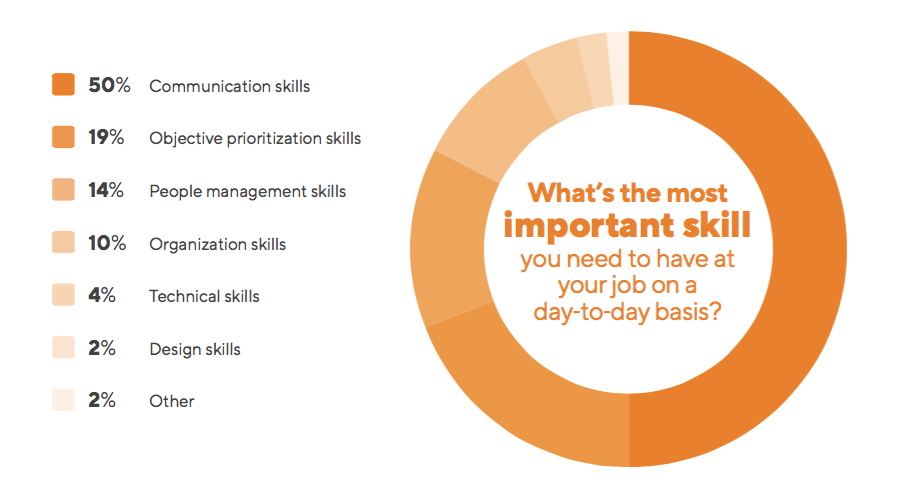In our fifth annual Product Management report, communication ranked the most important skill absolutely essential to the role of product management. When we cross-referenced by industry, product management communication skills still reigned supreme.

Product managers (PMs) are responsible for communicating strategy and updates across the team. To be happy and effective in your PM role, you need to be able to communicate well and across many different formats (e.g., in person, on-screen, via email, etc.).
Improve Your Communication Skills
Are your product management communication skills up to snuff? Here are seven little adjustments you can make to deliver a significant impact.
1. Listen up!
Before a product or feature is a twinkle in your eye, you need to gather information from many sources to help you make better-informed decisions about how to guide and improve your product. To accomplish this, you will need to be in active-listening mode. Just to clarify, listening doesn’t mean using the other speaker’s time to cue up your own thoughts or make a mental to-do list. Effective listening means that you are receiving and processing the information someone is sharing with you. Full stop.
“Good communication involves more listening than talking. Listen to what your team and customers are saying.” (Software product manager)
Effective listening may be a critical skill for PMs, but it doesn’t come naturally for everyone. Taking time to listen actively can also feel downright indulgent when your workday is brimming with endless tasks, meetings, and deadlines. Put these five key active listening techniques to use in your next conversation and see what transpires:
- Pay attention: This includes looking at the speaker directly, silencing distracting thoughts, refraining from preparing a response, and not straying from the topic.
- Show you’re listening: These are subtle social cues like maintaining an open posture, nodding or smiling periodically, and using verbal nudges to encourage the speaker to continue.
- Provide feedback: Ask questions to clarify points and use phrases like “What I’m hearing you say” or “Sounds like you are saying…” to reflect and summarize what the speaker has said.
- Defer judgment: This really means don’t interrupt. Allow the speaker to share an idea or thought before responding fully.
- Respond appropriately: Active listening isn’t about agreeing with everything the speaker says, but it is about respectfully creating the space to hear what someone else has to say. Your goal is to gain perspective and information, not to win an argument.
Big Impact:
As a product manager, you’ll find yourself interviewing subject-matter experts (both internal and external) about product details, the needs of the market, your competitors, your customers, budgetary and resource constraints, and other important strategic information. Truly listening — to hear and understand what each constituent is telling you — will help you synthesize all of this information intelligently and put it to use building the best product you can.
Effective listening also illustrates to customers that their experience is important to you and that you really do value their feedback and ideas. This, in turn, helps you to develop customer empathy and nurture a deeper connection.
Find out why silence is one of Jim Semick’s (ProductPlan founder and chief strategist) favorite under-appreciated product management skills.

2. Create a meeting agenda and stick to it.
Meetings are an endless component of PM life. You can’t avoid them. And truth be told, they are often useful and necessary for the product development cycle. But meetings that go sideways or never accomplish their intended goal are significant time wasters. Keep meetings focused and efficient by creating a clear meeting agenda. And then stick to it.
On the flip side, when you’re invited to a meeting, you still have a responsibility to ensure the meeting stays on course. Come prepared to share your knowledge, expertise, and ideas. And if the meeting organizer doesn’t include an agenda in the invite, ask for one! Time is a valuable resource. Don’t let fruitless, wayward meetings eat away at your day.
Big Impact:
Effective meetings should move product development forward, rather than stagnating the process or hampering progress. An agenda will help you hold all meeting participants accountable for the most significant impact.
3. Use roadmapping software.
Product management communication skills were voted the most important skill, but just 40 percent of PMs are happy with their process for communicating product strategy. In our experience, satisfaction in how PMs communicate that strategy often depends on the roadmapping tool they use. Dedicated roadmapping software tends to have a benefit over tools like Powerpoint and Excel because it is built specifically for product teams and their unique needs.
Big Impact:
As a PM, one of your key jobs is to be an evangelist for the product. A high-level visual presentation is a powerful way to help get buy-in on your strategy. This is one reason a visual product roadmap is an excellent way to go.
Our Product Management report shows that PMs primarily communicate their product strategy with a roadmapping software tool (like ProductPlan) at 28%, followed by presentation software at 24%. Interestingly, those who communicated the roadmap with a roadmapping software tool or a drawing software were the happiest with their current strategy.
4. Weave a good story.
As humans, we need to connect to ideas in a personal way. Your product team needs a reason to care about a new feature or product. Sell them on an original idea by telling a story — a story about a customer or how a new feature will solve a particular problem. User research can help you understand and craft the customer’s story.
Big Impact:
Storytelling is a great tool for PMs because stories tap into our emotions and lead us to act. Stories help product teams nurture a deeper understanding of the underlying needs and experiences of customers, which leads to better products. Compelling stories also motivate customers to buy a particular product or service.
Storytelling also comes into play with your product roadmap. A compelling story engages stakeholders emotionally and puts an elaborate strategic plan for your product into a simple framework they can easily understand and remember. And that’s much more likely to lead to the buy-in you need.
Learn how to shift your communication to appeal to your primary audiences in our webinar:
5. Do a dry run.
Few people naturally jump out of bed, ready to deliver a riveting speech or presentation. (For many of us, this is the stuff of nightmares.) The most engaging presenters out there follow some basic public speaking rituals before key meetings or presentations and give themselves time to fine-tune everything from material to delivery before going live.
Before your next presentation, try recording yourself during a dry run to pinpoint areas for improvement. In the moments leading up to an important meeting, warm up your muscles and shake out any tightness by doing a few facial exercises or quick arm and shoulder stretches. Ease your mind by having talking points on hand to refer to if your brain freezes. And be kind to yourself. Public speaking is hard for most of us!
Big Impact:
PMs are always in situations where they need to speak in front of others, deliver presentations, and lead discussions. Rather than winging it, taking time to rehearse and fine-tune what you have to say enables you to deliver your message with confidence.
6. Set the stage.
From time to time, you might find yourself on-screen in a video meeting with remote colleagues or customers. Before you go live, check your space for obvious distractions—silence noisy notifications on your phone. Adjust the lighting. And don’t forget to do a quick video preview and check your teeth.
Big Impact:
There’s an increased level of visual scrutiny on-screen. After completing your dry run to-dos, take a few minutes to reduce audio or visual distractions in your physical space before going live for an online meeting.
7. Be aware of body language.
We communicate a great deal of additional information with subtle body language (e.g., crossing arms, turning our back to someone, smiling too much or too little, or avoiding eye contact). Multitasking during a meeting or conversation sends a powerful message, as does rushing someone through a conversation. Be aware of what you might be unintentionally communicating.
Big Impact:
Sometimes, what isn’t said is the most powerfully communicated. Don’t ignore subtle cues that undermine your intention and ability to connect.
Learn more about how soft skills, like communication, will help you in your product management career and even your personal life.


